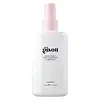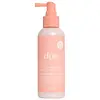What's inside
What's inside
 Key Ingredients
Key Ingredients

No key ingredients
 Benefits
Benefits

 Concerns
Concerns

 Ingredients Side-by-side
Ingredients Side-by-side

Water
Skin ConditioningBehenamidopropyl Dimethylamine
EmulsifyingCetearyl Alcohol
EmollientLactic Acid
BufferingAdansonia Digitata Seed Oil
EmollientArgania Spinosa Kernel Oil
EmollientMel
EmollientSodium Benzoate
MaskingHydroxypropyltrimonium Honey
Panthenol
Skin ConditioningParfum
MaskingHydrolyzed Wheat Protein
Skin ConditioningHydrolyzed Adansonia Digitata Seed Extract
Benzyl Alcohol
PerfumingSaccharomyces/Magnesium Ferment
Sorbic Acid
PreservativeSaccharomyces/Iron Ferment
Skin ConditioningPotassium Sorbate
PreservativeSaccharomyces/Zinc Ferment
Skin ConditioningSaccharomyces/Copper Ferment
Skin ConditioningSaccharomyces/Silicon Ferment
Skin ConditioningCoumarin
PerfumingHexyl Cinnamal
PerfumingLimonene
PerfumingLinalool
PerfumingWater, Behenamidopropyl Dimethylamine, Cetearyl Alcohol, Lactic Acid, Adansonia Digitata Seed Oil, Argania Spinosa Kernel Oil, Mel, Sodium Benzoate, Hydroxypropyltrimonium Honey, Panthenol, Parfum, Hydrolyzed Wheat Protein, Hydrolyzed Adansonia Digitata Seed Extract, Benzyl Alcohol, Saccharomyces/Magnesium Ferment, Sorbic Acid, Saccharomyces/Iron Ferment, Potassium Sorbate, Saccharomyces/Zinc Ferment, Saccharomyces/Copper Ferment, Saccharomyces/Silicon Ferment, Coumarin, Hexyl Cinnamal, Limonene, Linalool
Water
Skin ConditioningEthylhexyl Olivate
Skin ConditioningIsopentyldiol
HumectantAcrylamidopropyltrimonium Chloride/Acrylates Copolymer
Isoamyl Laurate
EmollientButylene Glycol
HumectantMoringa Oleifera Seed Oil
EmollientSqualane
EmollientOpuntia Ficus-Indica Seed Oil
EmollientSelaginella Lepidophylla Extract
EmollientOpuntia Ficus-Indica Flower Extract
Skin ConditioningMelia Azadirachta Leaf Extract
Skin ConditioningMoringa Oleifera Leaf Extract
Skin ConditioningCitrus Aurantium Dulcis Peel Oil
MaskingLactobacillus Ferment
Skin ConditioningEclipta Prostrata Extract
Skin ConditioningSorbitan Isostearate
EmulsifyingPalmitamidopropyltrimonium Chloride
Propylene Glycol
HumectantLinalool
PerfumingGlycerin
HumectantBenzyl Salicylate
PerfumingCitronellol
PerfumingGeraniol
PerfumingCetrimonium Chloride
AntimicrobialLimonene
PerfumingParfum
MaskingIsohexadecane
EmollientSilicone Quaternium-22
Polyglyceryl-3 Caprate
EmulsifyingDipropylene Glycol
HumectantCitric Acid
BufferingEthylhexylglycerin
Skin ConditioningCoceth-7
EmulsifyingCocamidopropyl Betaine
CleansingPhenoxyethanol
PreservativeWater, Ethylhexyl Olivate, Isopentyldiol, Acrylamidopropyltrimonium Chloride/Acrylates Copolymer, Isoamyl Laurate, Butylene Glycol, Moringa Oleifera Seed Oil, Squalane, Opuntia Ficus-Indica Seed Oil, Selaginella Lepidophylla Extract, Opuntia Ficus-Indica Flower Extract, Melia Azadirachta Leaf Extract, Moringa Oleifera Leaf Extract, Citrus Aurantium Dulcis Peel Oil, Lactobacillus Ferment, Eclipta Prostrata Extract, Sorbitan Isostearate, Palmitamidopropyltrimonium Chloride, Propylene Glycol, Linalool, Glycerin, Benzyl Salicylate, Citronellol, Geraniol, Cetrimonium Chloride, Limonene, Parfum, Isohexadecane, Silicone Quaternium-22, Polyglyceryl-3 Caprate, Dipropylene Glycol, Citric Acid, Ethylhexylglycerin, Coceth-7, Cocamidopropyl Betaine, Phenoxyethanol
Ingredients Explained
These ingredients are found in both products.
Ingredients higher up in an ingredient list are typically present in a larger amount.
Limonene is a fragrance that adds scent and taste to a formulation.
It's found in the peel oil of citrus fruits and other plants such as lavender and eucalyptus. The scent of limonene is generally described as "sweet citrus".
Limonene acts as an antioxidant, meaning it helps neutralize free radicals.
When exposed to air, oxidized limonene may sensitize the skin. Because of this, limonene is often avoided by people with sensitive skin.
The term 'fragrance' is not regulated in many countries. In many cases, it is up to the brand to define this term. For instance, many brands choose to label themselves as "fragrance-free" because they are not using synthetic fragrances. However, their products may still contain ingredients such as essential oils that are considered a fragrance.
Learn more about LimoneneLinalool is a fragrance and helps add scent to products. It's derived from common plants such as cinnamon, mint, citrus, and lavender.
Like Limonene, this ingredient oxidizes when exposed to air. Oxidized linalool can cause allergies and skin sensitivity.
This ingredient has a scent that is floral, spicy tropical, and citrus-like.
Learn more about LinaloolParfum is a catch-all term for an ingredient or more that is used to give a scent to products.
Also called "fragrance", this ingredient can be a blend of hundreds of chemicals or plant oils. This means every product with "fragrance" or "parfum" in the ingredients list is a different mixture.
For instance, Habanolide is a proprietary trade name for a specific aroma chemical. When used as a fragrance ingredient in cosmetics, most aroma chemicals fall under the broad labeling category of “FRAGRANCE” or “PARFUM” according to EU and US regulations.
The term 'parfum' or 'fragrance' is not regulated in many countries. In many cases, it is up to the brand to define this term.
For instance, many brands choose to label themselves as "fragrance-free" because they are not using synthetic fragrances. However, their products may still contain ingredients such as essential oils that are considered a fragrance by INCI standards.
One example is Calendula flower extract. Calendula is an essential oil that still imparts a scent or 'fragrance'.
Depending on the blend, the ingredients in the mixture can cause allergies and sensitivities on the skin. Some ingredients that are known EU allergens include linalool and citronellol.
Parfum can also be used to mask or cover an unpleasant scent.
The bottom line is: not all fragrances/parfum/ingredients are created equally. If you are worried about fragrances, we recommend taking a closer look at an ingredient. And of course, we always recommend speaking with a professional.
Learn more about ParfumWater. It's the most common cosmetic ingredient of all. You'll usually see it at the top of ingredient lists, meaning that it makes up the largest part of the product.
So why is it so popular? Water most often acts as a solvent - this means that it helps dissolve other ingredients into the formulation.
You'll also recognize water as that liquid we all need to stay alive. If you see this, drink a glass of water. Stay hydrated!
Learn more about Water